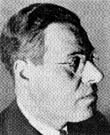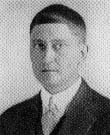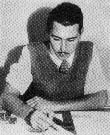people | places | products | philosophy
index | references
|
The Bauhaus people, places, products & philosophy |
|
 Walter Gropius
Johannes Itten
Laszlo Moholy-Nagy
Josef Albers
Herbert Bayer |
Bauhaus people The Bauhaus school existed in Germany from 1919-1933. During that time it moved from Weimar to Dessau to Berlin. The staff's diverse background contributed to a comprehensive course study during each of these periods. Each of the instructors were well respected artist, architects and artisans in their own right. Many of those involved with the Bauhaus, professors as well as students, have their own place in art history books. Vasily Kandinsky and Paul Klee are examples of those best known for the legacy of art work, rather than being involved with the Bauhaus. However, a number of professors are mainly known for their involvement with the Bauhaus more than anything else. Walter Gropius founded the Bauhaus school in Weimar Germany in 1919. He is the primary name associated with the Bauhaus and was the key person in shaping its philosophy. He was the director in Weimar and Dessau. Gropius was an architect, which influenced the initial course offerings and philosophy of the school. Gropius coined the term Bauhaus which means 'building house' in German. An early accomplishment in Gropius's career was a factory design for the Fagus Shoe Company. The adoption of structural steel and ferroconcrete freed the wall of its function as a structural element. Thus, to Gropious and those who followed the International Style of the 1920s, the wall was merely a curtain or climate barrier.(Arnason, p.312) Gropius was one of the first architects consistently design buildings using the wall in this manner. Many of his buildings used all glass walls, which was not common at the time. The "glass curtain" is now used by most architects, and can be seen in any modern city. -more- Johannes Itten was initially responsible for teaching the preliminary 'basic' course. However, his philosophical perspective did not suite the Bauhaus. A rift developed over Itten's belief that one could attain "personal salvation through mystical communion with matter", his followers "sought to transcend reality, and in doing so they questioned the fundamental premises of Bauhaus teaching."(Naylor, p.66) Itten's contribution to visual communication was in the area of color, his book The Art of Color was subtitled A treatis on the color system. He said of color, "He who wants to become a master of color must see, feel, and experience each individual color in its many endless combinations with all other colors. Colors must have a mystical capacity for spiritual expression, without being tied to objects." (Itten, p.6) Despite Itten's mystical slant, his color research is valuable to visual design for its theoretical framework. In his treatis, Itten included color plates, to show the effects of colors next to, and on top of each other. -more- Laszlo Moholy-Nagy took over the preliminary basic course in 1923 after Itten left. He was involved with the de Stijl group, which was considered an opposing art movement. The fact that Gropius chose to ask Moholy-Nagy to teach each at the Bauhaus was a credit to his skills a building a movement. Moholy-Nagy was interested in typography, photography and cinema. (Naylor, p.76-79) Of all the teachers and many students, Moholy-Nagy was the most important to the development of visual communications. He was one of the pioneers of camera-less photography. Moholy-Nagy, like many of the other professors, went to America after his involvement with the Bauhaus. He eventually founded the Institute of Design in Chicago, later called the Illinois Institute of Design. -more- Josef Albers was involved in research on the emotional and perceptual impact of color, line and geometric forms. His contributions included developing methods of educational instruction. Albers was accomplished in furniture design, lettering and glass painting. Albers went to the United States, after the Bauhaus was closed, and first taught at the Black Mountain College in North Carolina, then at the Cincinnati Art Academy, Yale, the Pratt Institute and at Harvard.(Wingler, p.422) He influenced the Abstract Expressionist of the 1950. Whose likes included Stella, Noland and Olitski, whose work is characterized by large shapes and flat color. Alber's book, Interaction of Color, is a corner stone of today's art classroom. Several years later Albers produced a series of paintings called Homage to the Square. At first glance, and viewed alone, these paintings appear to be flat color squares on top of each other. However, as a series, they represent further commentary on the interaction of colors, how colors act when next to each other. The Abstract Expressionist of the New York school were referencing Albers's work for their inspiration. Many of these large pieces, or similar ones more recently produced, are displayed in the atrium of large "modern glass buildings". -more- Herbert Bayer's responsibility at the Bauhaus included typography and advertising techniques. (Wingler, p.423) Bayer also set up Bauhaus design exhibitions. He later went to America, where he developed exhibition techniques and commercial art. Major department stores, as well as advertising agencies employed him as an art consultant. (Wingler, p.423) He was very influential in developing commerical art as a profession in America. Other professors, at the Bauhaus included Kandinsky, Klee, Breuer, Meyer. Each of whom have been featured in their own exhibitions. Kandinsky greatly influenced early abstract expressionism. Paul Klee wrote Pedagogical Sketchbook which is an intellectual analysis of his own work. It illustrates the marriage of scientific and mathematical precision with the organic processes of the imagination.(Piper, p.657) Students, included Max Bill who helped found the Ulm Hochschule fur Gestaltung (Technical College for Design). This German school was founded in 1950 and reflected the functionalist Bauhaus principles. (Livinston, p.28) Eliot Noyes was a student of the Bauhaus who helped develop the IBM Coporate Identity with Paul Rand (Livinston, p.103). More than 1250 student spent some time at the Bauhaus. Those students then spread the Bauhaus philosophy of art and industry working hand-in-hand.
Originaly launched November 1996. Last updated 2008. |



